Body Image and Social Media: The real impact “Instagram vs. Reality” posts have on our mental health
Taking a look at how social media is evolving and the effects journalism has on body image.
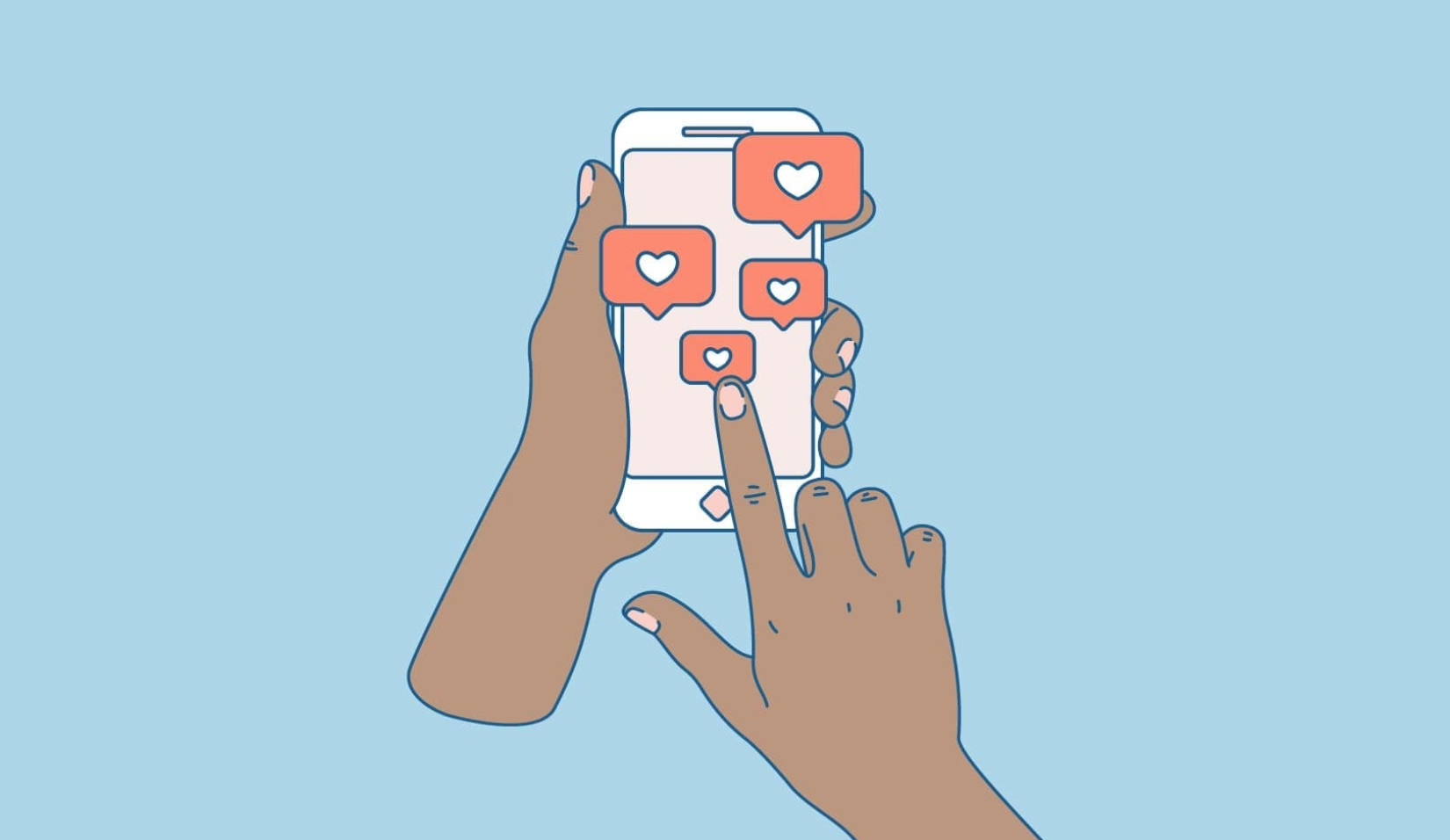
“Instagram vs. Reality” started as a trend on social media involving influencers and celebrities, to show their followers that they shouldn’t believe everything they see online.
The idea is that, through all the editing, angles and somewhat perfect bodies, the final “Instagram” image is just one moment captured amongst many less flattering shots that don’t quite make it. The trend shows the edited picture side-by-side with a more natural and unedited image; usually with a caption promoting body positivity, in order to encourage loving yourself in the skin you're in. Currently, the ‘Instagram vs. Reality’ hashtag has over 170k posts, and is widely known as a body positivity hashtag on Instagram. Most people who use social media push to look their best in photos to get hundreds of likes, or even just to look good for that one person. Therefore, by using this hashtag, influencers and celebrities are working to normalise bodies in their natural state, and reveal the truth behind Instagram’s culture of “perfection”.
Body positivity has its roots in the fat acceptance movement of the late 1960s and focuses on changing society's ideals of what a woman should look like. Being Body Positive involves accepting and loving your body, whilst advocating for more representation of bodies that differ from the mainstream beauty ideal. Therefore, being body positive also requires you to respect the bodies of others, no matter how far they deviate from conventional societal standards. Freelance journalist and Body Positivity advocate, Stephanie Yeboah, frequently discusses the lack of varied body types shown in the media, and how this negatively affected her own self esteem when she was younger. She is vocal about eradicating the negative use of the word ‘fat’, in order to help those who are plus size feel confident in themselves, and she regularly posts about how she overcame her own struggles with body image.
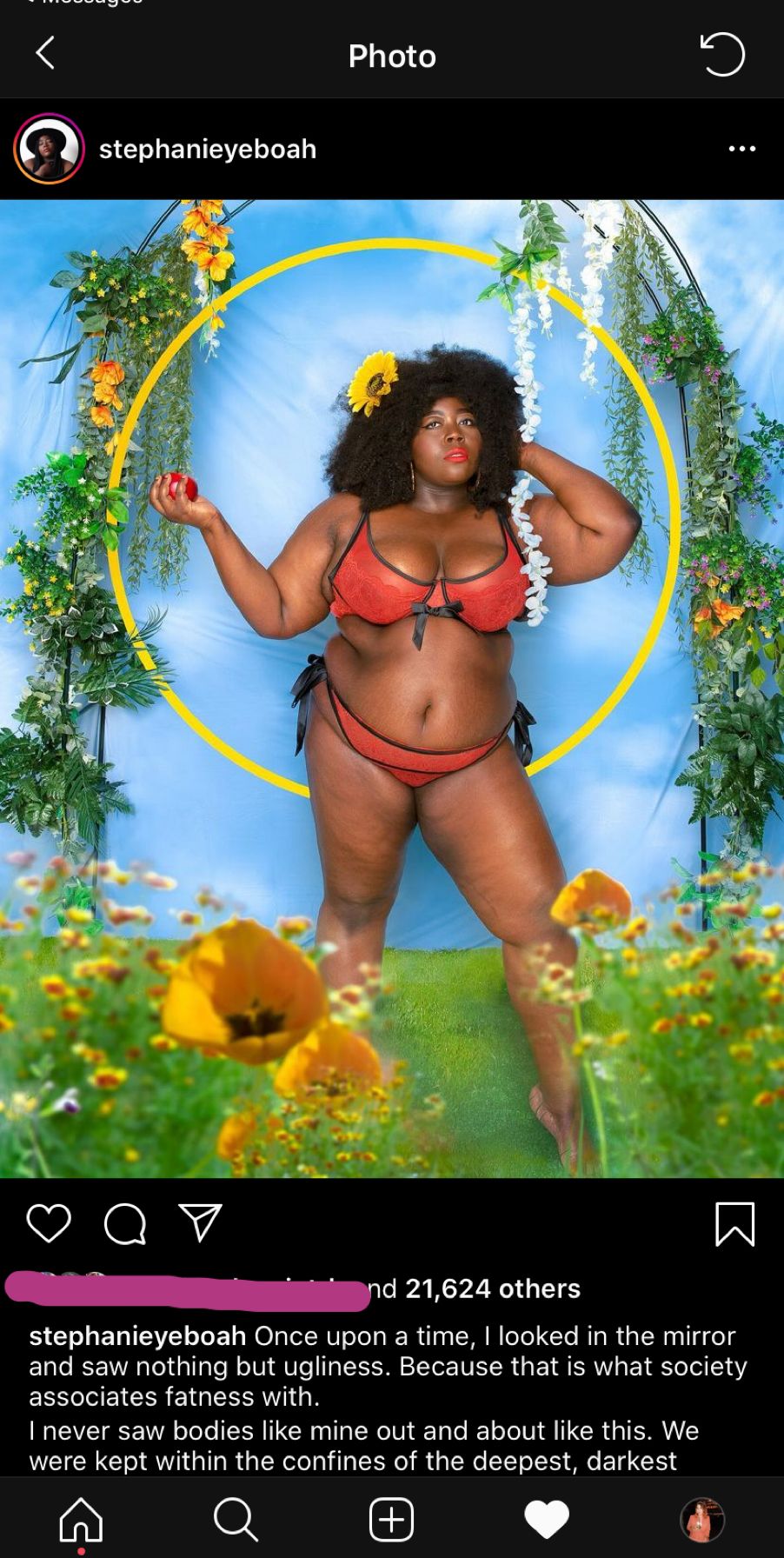
However, some argue that Body Positivity adds another element of pressure and impossible standards to live up to. If we do not fit into society’s conventional beauty ideal, we now have to be positive about our imperfection. Enter the world of social media and the beloved internet.
From Facebook and Twitter, to Tumblr and Instagram, social media platforms allow anyone and everyone to post photos of whatever they like - particularly photographs of themselves. Body Positivity, however, is a big topic online today, attempting to tackle the over editing, photoshopped images to let people post who they truly are with confidence. The body ideal has shifted throughout the years, but now, we have hundreds of editing apps available to us to match whatever body shape is “in”, with body sculpting and contouring features to edit yourself into so called perfection. All the while, sabotaging our self esteem and making ourselves unhappy with how we really look.
Here, we have a TED Talk where twin sisters discuss the damaging effects that photoshop can have on an individual’s self-image.
With all this said, the concept of "Instagram vs. Reality" sounds like a positive new route for influencers to help younger generations grow up without feeling negatively towards themselves, highlighting the fakery that surrounds the Instagram homepage. But is it all that it seems?
On the one hand, a recent content analysis of body positive content on Instagram hashtags, such as #InstagramVsReality and #bodypositivity, shows that these posts do indeed depict a broad range of body sizes and appearances. The content included in these hashtags are selfies of women proudly displaying their belly rolls and cellulite, and the before and after photos of “real” vs “edited” bodies, raising awareness of the common use of Photoshop on Instagram. There are also workout videos of ladies of all shapes and sizes there to motivate and inspire under the ‘Instagram vs. Reality’ hashtag.
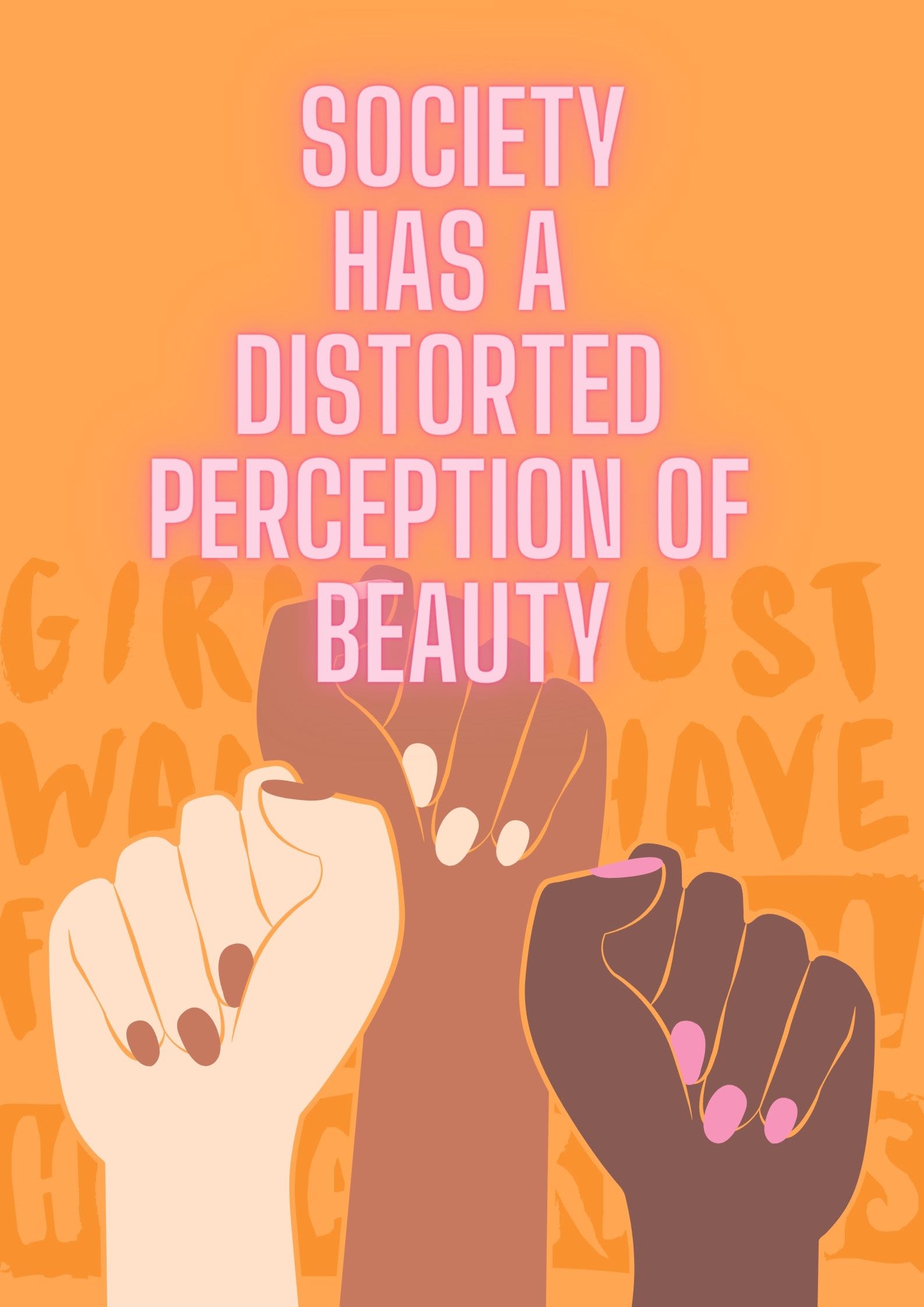
Poster by Laura Benwell, Quote found on pinterest (user anon)
Poster by Laura Benwell, Quote found on pinterest (user anon)

Image by Chessie King
Image by Chessie King
"Bodies that look like this, also look like this" - Mary Skinner, Tiktok Star

A notable example of body positivity content can be found in Danae Mercer, a consistent user of the ‘Instagram vs. Reality’ hashtag. Danae is an influencer and journalist who has previously suffered from an eating disorder, and she is now on social media exposing common tricks that influencers and celebrities use to create the “perfect” image.
Danae Mercer executes the ‘Instagram vs. Reality’ trend appropriately in line with its body positive roots. Looking at her Instagram profile, it is clear that she consistently posts similar candid images, promoting a positive outlook of self-love and loving the skin you’re in.
She uses the hashtag ‘Instagram vs. Reality’ on the majority of her posts and really sheds light on the cause, letting her 2.1 million followers know that cellulite, rolls and texture are all part of the natural body. She is using her platform to spread the body positive message, and therefore, her use of the hashtag is genuine, as she really seems to want to break down myths to her audience, and not just use the hashtag as an attempt to seem more “relatable”.
Not only is it just one post out of the whole of her feed, it is a consistent stream of posts with the hashtag ‘Instagram vs. Reality’. Danae said she wants to "remind people that what we see online is incredibly filtered, posed, and perfected.” She poses the questions that society would usually be too afraid to ask, challenging the body ideal, making it easier for her followers to follow in her footsteps.
Danae Mercer's Youtube Channel
Social media platforms are a great place to join new communities and find inspiration, but who you choose to follow can impact upon your mental health. For example, following like-minded, body positive influencers will have a better impact on your mental health and how you view yourself, but it is sometimes difficult identifying those people to follow amongst the crowd..
Having an online platform with so many followers holds a lot of responsibility. When you have that many followers, the pressure is on to represent yourself in the best possible way.
Danae Mercer received comments from followers, applauding her Instagram account for helping them through their negative thoughts and self-doubt. Mercer’s story has truly resonated with her audience due to the candidness of her posts. "So many women around the world are struggling with body image, mental health, self-confidence in photos, their relationships with social media, the food they eat, consent, all these things, So quite often I get really powerful messages from women just wanting to share their stories. And that's just incredible — it makes me feel really, really grateful" she said.
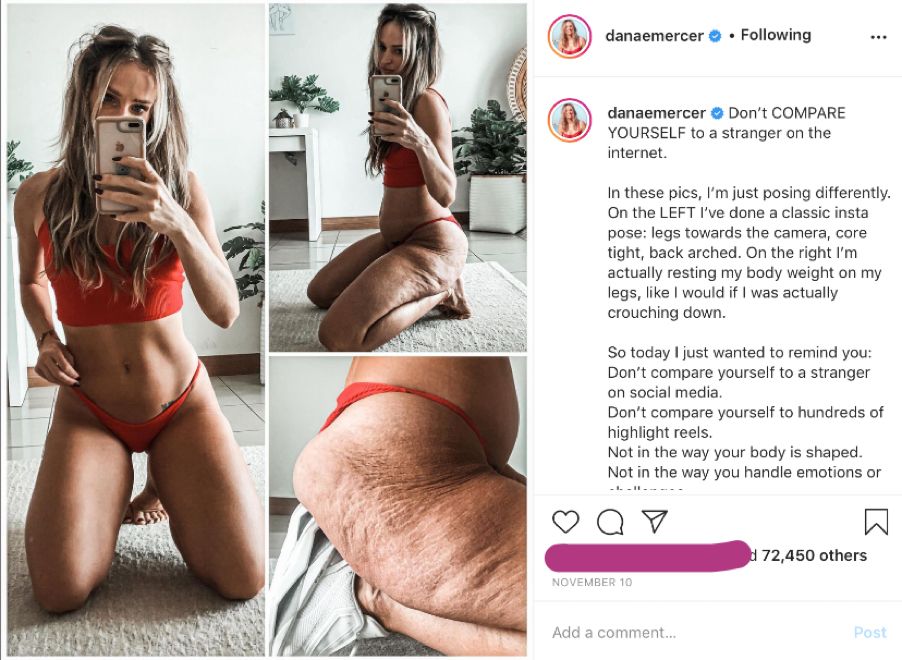
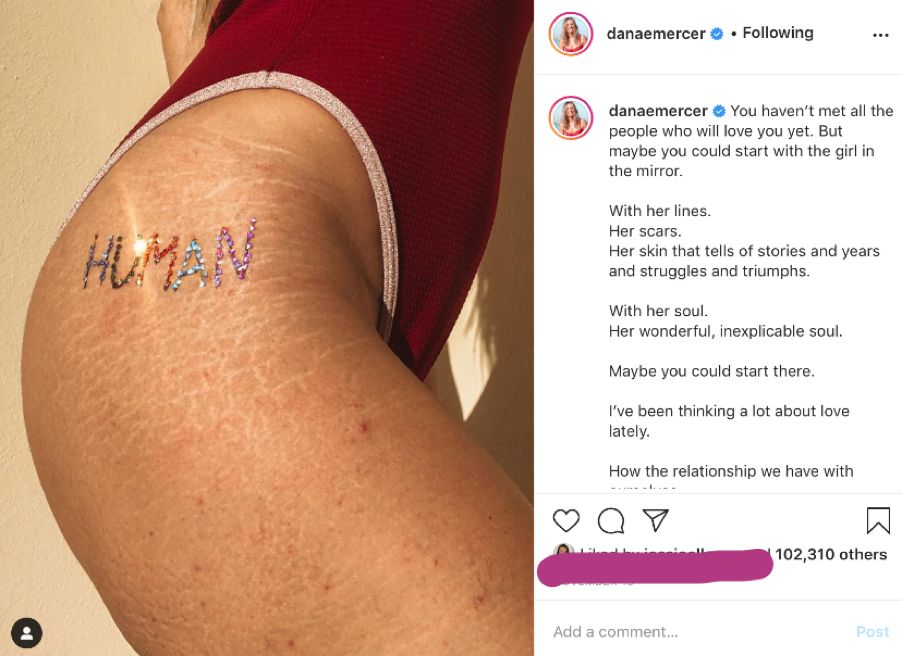
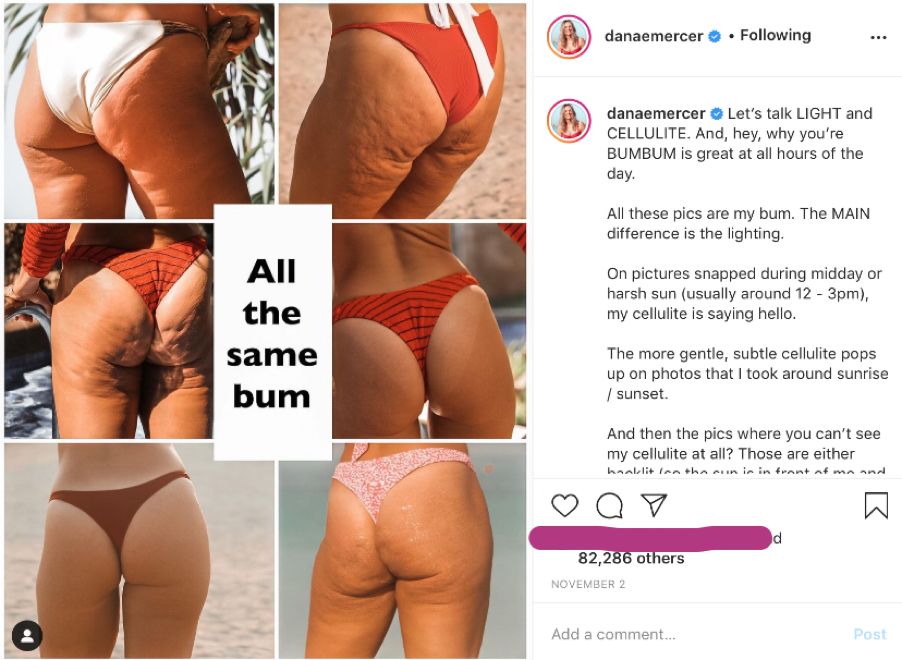
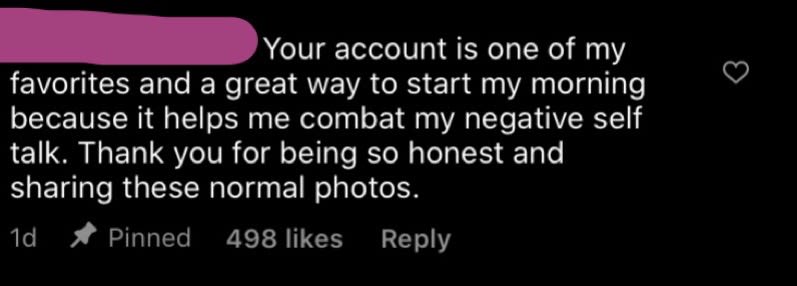
Comment taken from Danae Mercer's Instagram.
Comment taken from Danae Mercer's Instagram.
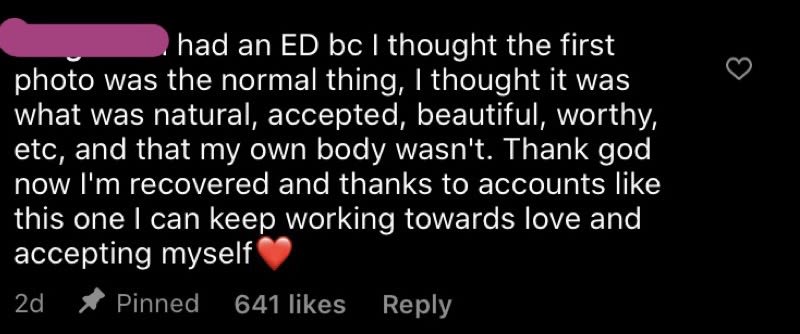
Comment taken from Danae Mercer's Instagram.
Comment taken from Danae Mercer's Instagram.
When searching the hashtag, the name Chessie King appears in many of the top posts. Chessie is a body positive influencer who uses Instagram and her platform to help women with body confidence issues, and improve their outlook of life, rather than dwelling on the image that reflects back in the mirror. Chessie’s account is full of side-by-side images, which has now become her staple to demonstrate the ways in which makeup, posing, lighting and angles all manipulate the way we look on Instagram.
Dr Bono informed Bored Panda"I’ve been doing research on this for several years now and the data I’ve collected on this topic has shown that the more time people spend on social media, the more likely they are to experience negative outcomes psychologically".
While browsing social media, it takes just moments to see where people have edited their photos and how unrealistic it can be, especially when placed side by side with one another. By having these body positive accounts exposing the ways influencers and celebrities can change the way they look, audiences can then question who they follow. With this information, audiences will hopefully then curate a new feed, which instead promotes body positivity and mental wellbeing.
All images in this scrollmation by Chessie King
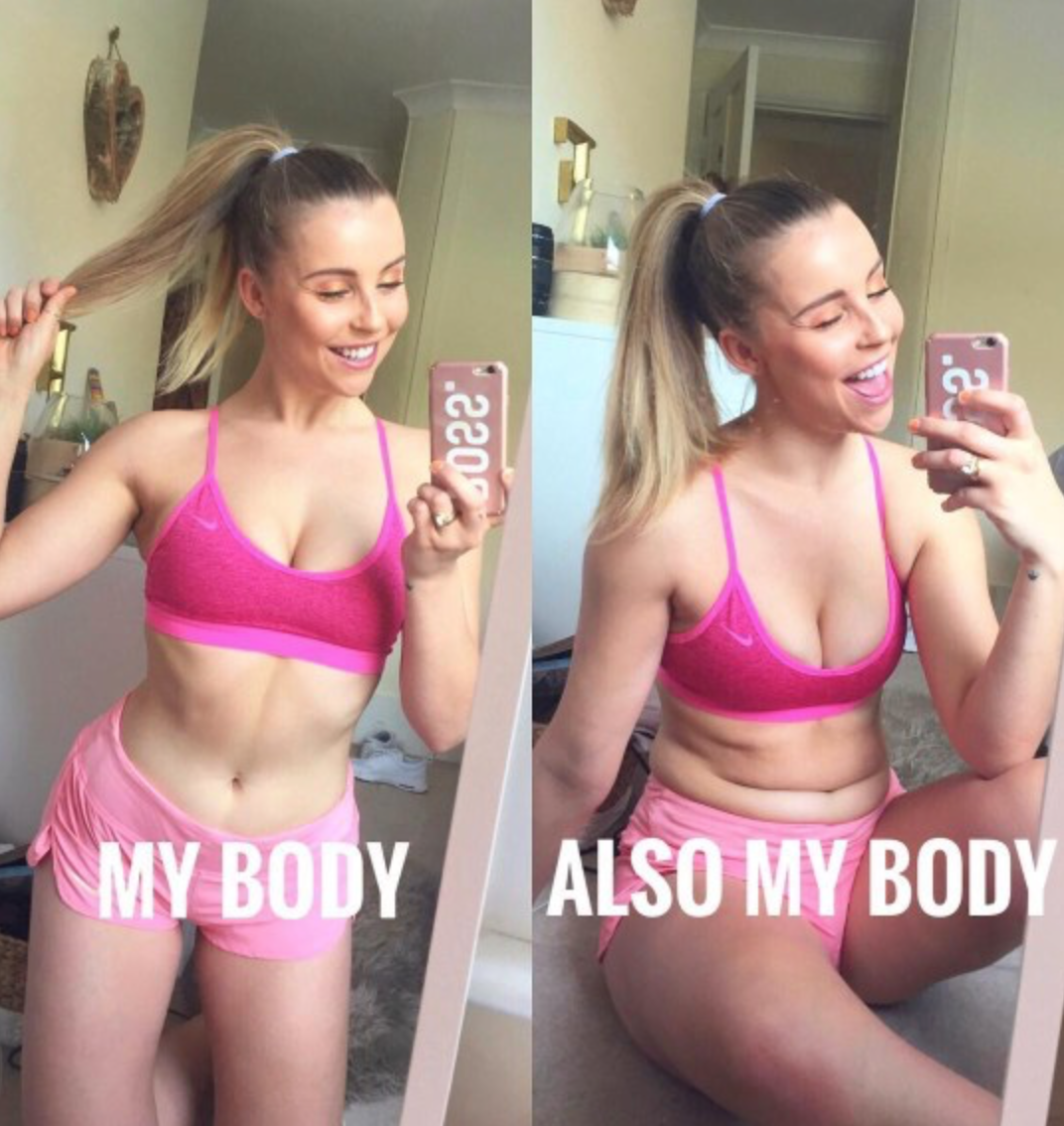
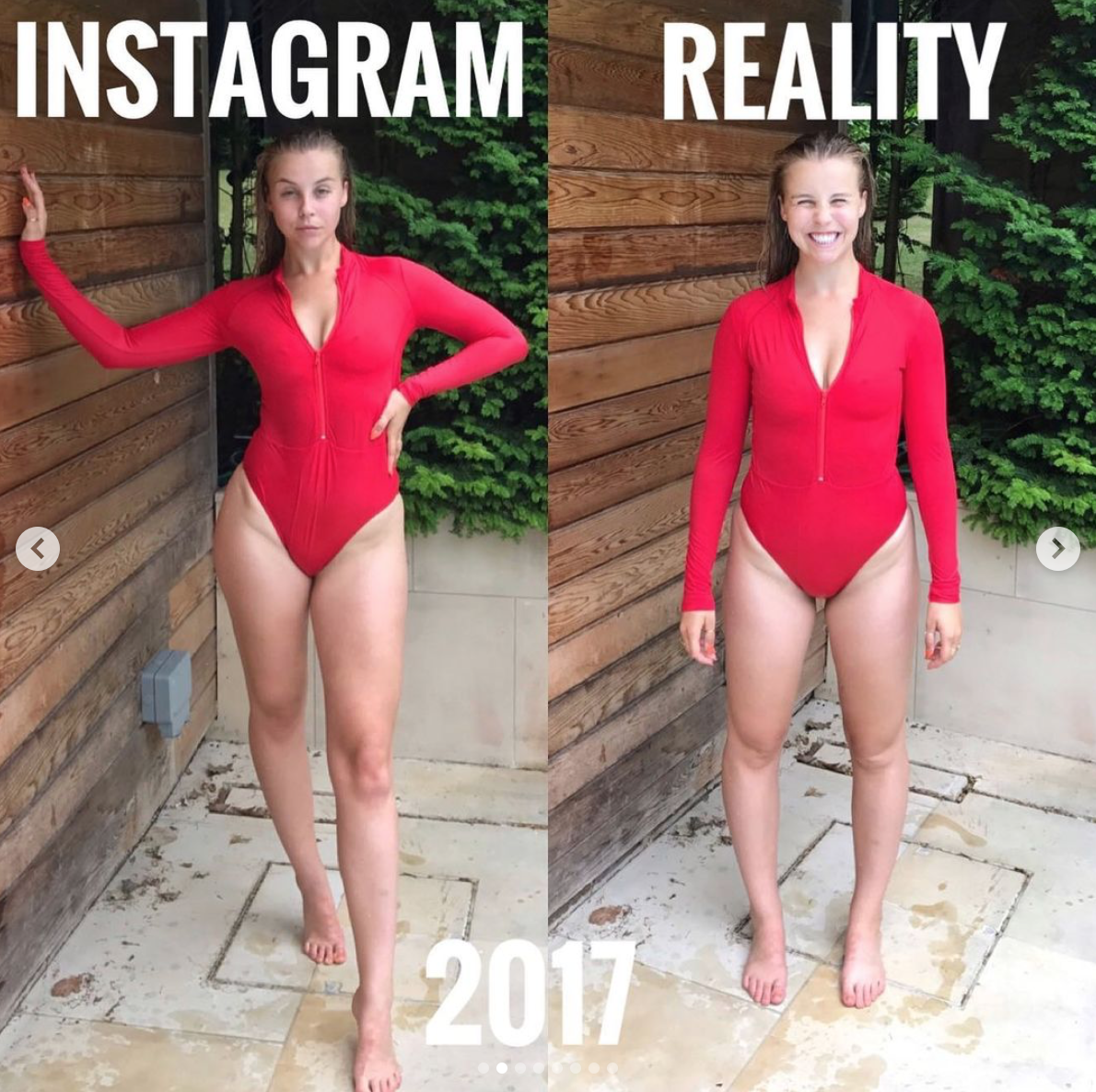
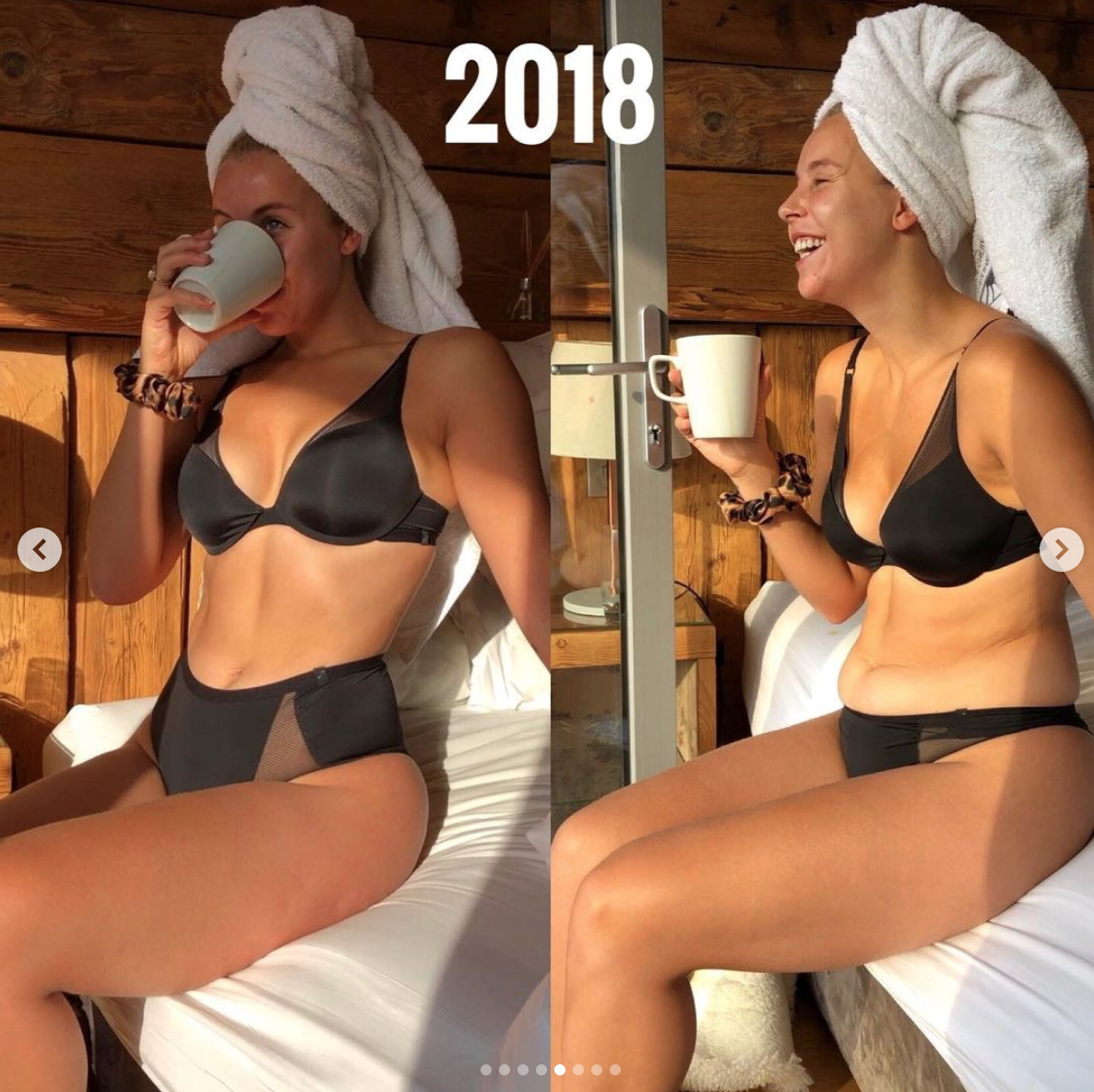
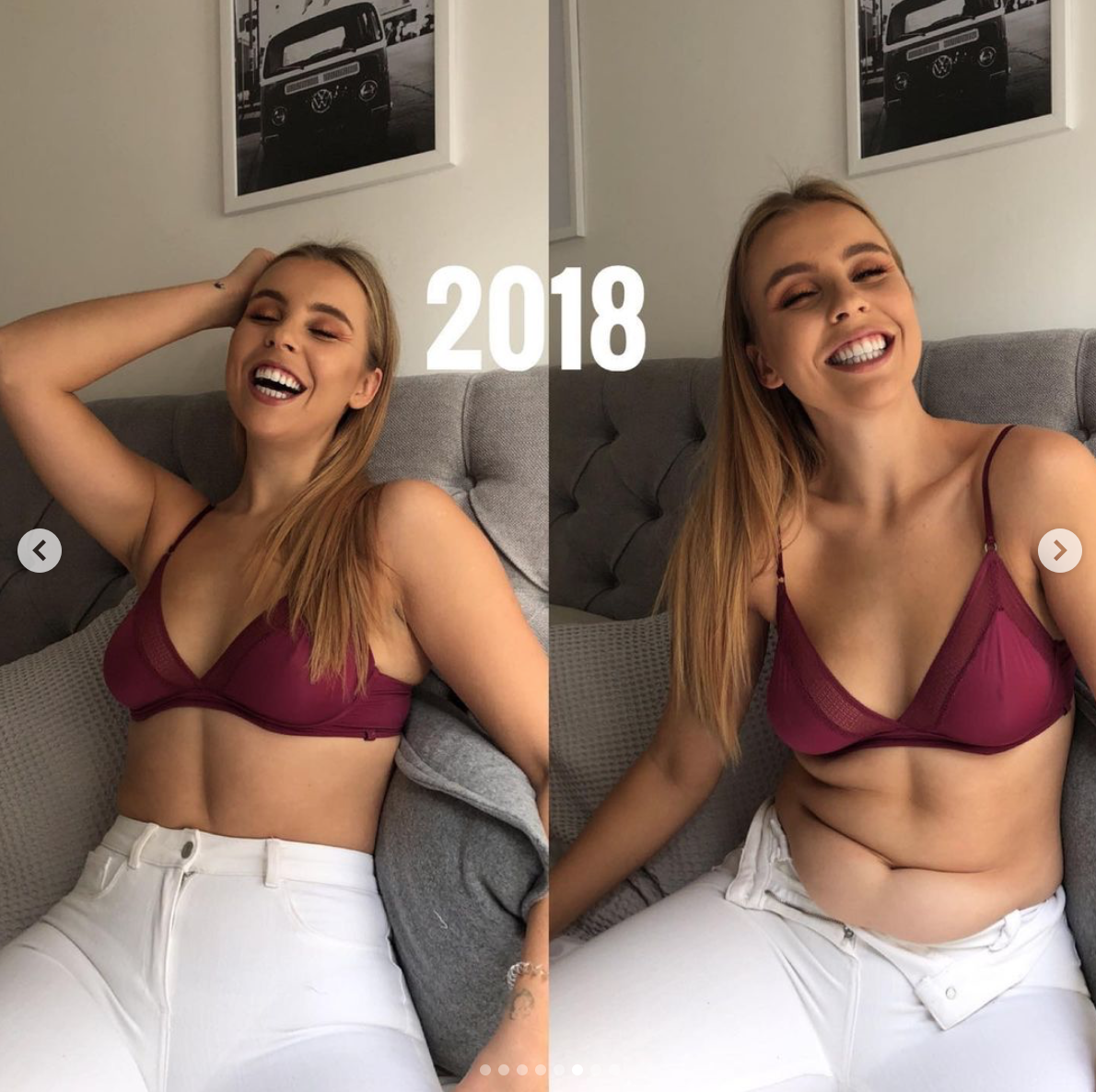

Nelly London, a.k.a. ‘That girl with the hip dips’, is another influencer who is sending out positive, uplifting messages to women everywhere.
Her feed is full of exposed, honest and beautiful images of herself. She normalises her scars, hip dips, cellulite and all the things that make us human, and her page features many lingerie and nude photographs, which her audience love.
Nelly receives many comments from women who have the same body type or similar features to her, and seeing her posts makes these women feel proud of their own bodies, instead of wanting to hide away. Her main message to her audience is to love yourself and everything you’ve been given.
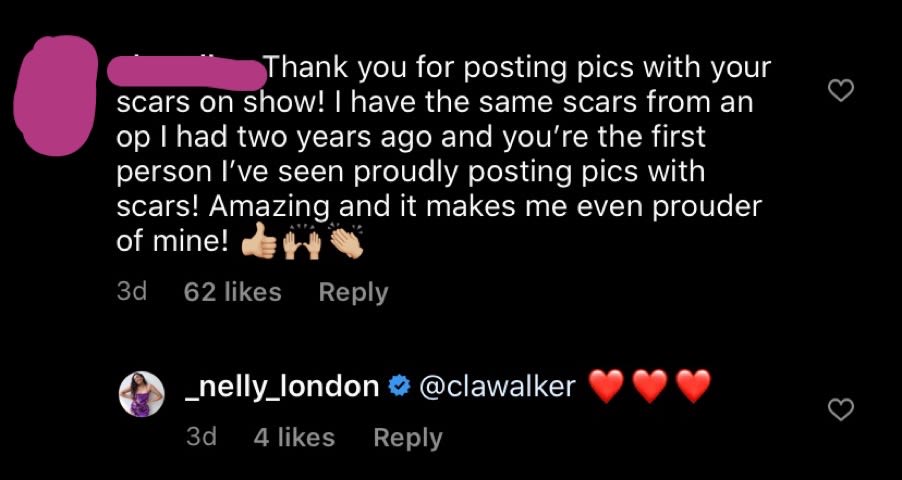
Despite not using the hashtag ‘Instagram vs. Reality’, Nelly posts side-by-side images that would typically be found on the trend. Her images are followed by captions, which explicitly tell her followers how photographs can be manipulated by companies to instantly change the way your body looks, and she therefore provides similar insights to those in the ‘Instagram vs. Reality’ hashtag.

Nelly talks openly about her weight, past eating disorders and general girly chat, which makes her followers feel close to her. When influencers are raw and open in this way, it has the power to influence their audience in a far more positive way and promote healthier habits, pushing the audience to consider being kinder to themselves and change the way they feel towards their own bodies.
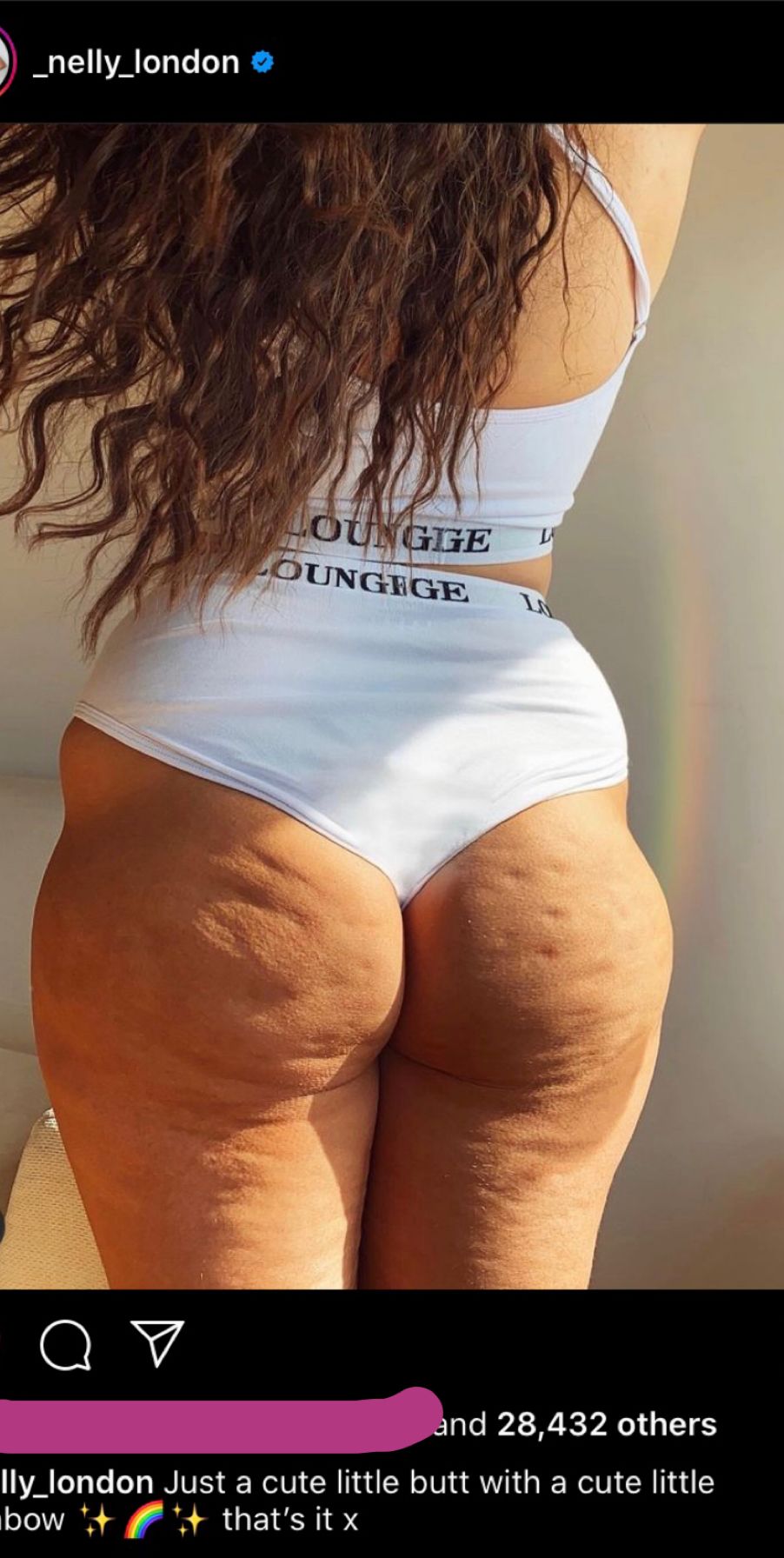
However, after looking at the positive side of the ‘Instagram vs. Reality’ hashtag, it’s important to explore the way the hashtag has also been hijacked by some celebrities to somehow appear ‘relatable’, whilst still looking perfect, or as close to it as possible.
Some celebrities and influencers are being ‘mocked’ for their use of the ‘Instagram vs. Reality’ trend. The trend is meant to demonstrate body positivity and how women look without all the filters and editing, yet some influencers are simply using the hashtag to show their posed photographs vs. a glamorous outtake.
Lina Noory is a digital creator with over 362K followers on Instagram and she’s posted using the ‘Instagram vs. Reality’ hashtag. However, she does not convey the same message as body positive influencers such as Danae, as her ‘Reality’ picture is just an attractive outtake of the ‘Instagram’ picture; no facial expression and a bit of wind through her hair. Although she may appear to have good intent, as she reminds her audience in the caption to not compare themselves to ‘someone’s perfectly posted Instagram photo’, the post does not feel honest, as she remains glamorous and has used edits and filters, which is not what the hashtag was intended for.
Similarly, Instagram influencer Chloe Haywood posted an ‘Instagram vs. Reality’ photo where she looks just as attractive in each image.
Again, there is hardly any difference between the photographs; the first ‘Instagram’ image is simply more posed than the latter ‘Reality’ image, where the only difference is that she looks happier and in a slightly different position. Both images could easily be used as a normal Instagram post, as neither expose the tricks and editing behind the final photo. Instead, by using another perfect picture as her “Reality” image, Chloe reinforces the unrealistic perfection that is required of users on Instagram in 2020 - as both photographs are ‘insta-worthy’. Everyone has their insecurities, so it’s not to say that Chloe didn’t prefer the first image. However, with such a large following, the trend was used incorrectly and irresponsibly, as she promotes the idea that even “mugshots” should be edited and posed to perfection.
Although both women may have used the hashtag on their posts with good intent, they each still follow the expectations of women and the culture of Instagram perfection, as neither show their audience any real flaw or imperfection. This is where the issue lies in their use of the “Instagram vs. Reality” hashtag.
The trend has also been taken over by some influencers, again not to speak about body positivity, but instead to show ‘before and afters’ of a normal photo shoot, or ‘the outtakes’. Influencer and Youtuber, @_Emilysworld, used the hashtag on this photograph to demonstrate her ‘Instagram vs. Reality’, but she misses the whole objective of the trend. In the former image, she’s posed and it’s been constructed in a particular way, but interestingly, so has the latter, which begs the question - how many “Reality” photos did she take before finding the right one? Although it’s clear that she is still commenting on the fakery of Instagram, as Emily chooses not to edit or filter the latter photo, she still positions herself in a way that is rather posed, with her scarf on her head, pulling a silly face. Therefore, even though her post does work more towards the goals of the ‘Instagram vs. Reality’ hashtag, she is still not empowering women through the trend, but rather, making it more lighthearted than originally intended.
The audience’s comments towards this type of Instagram post are completely different to the comments on the posts using the hashtag correctly above. The audience is focused on how good the influencer looks and describes wanting to look like them in each photograph, whether it is posed or an outtake. Whereas, Danae, Chessie and Nelly receive comments that are more personal, with their audience telling their own stories, thanking the influencers for being so honest on their pages and describing how these types of posts have helped them with their self-confidence.
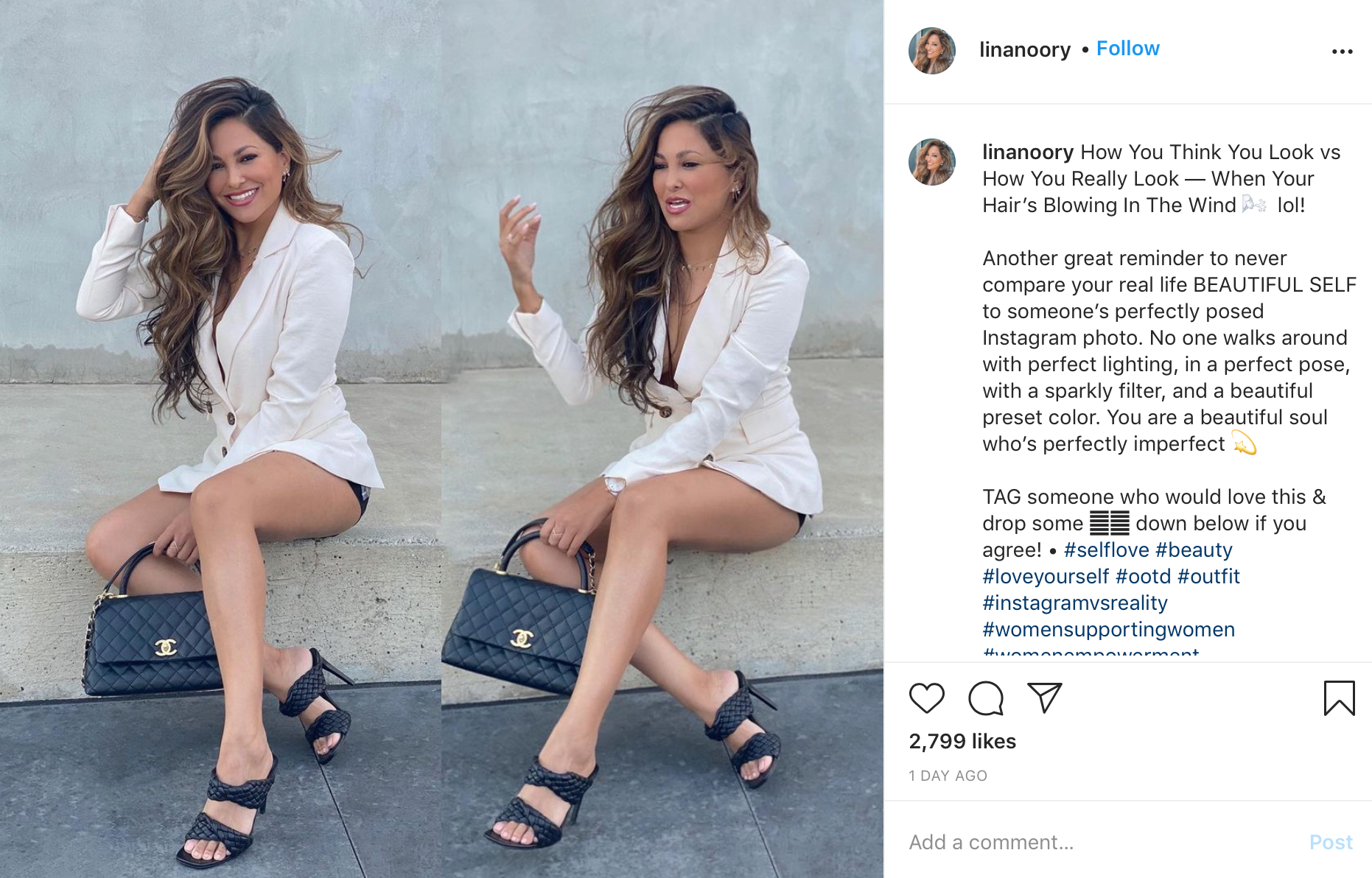
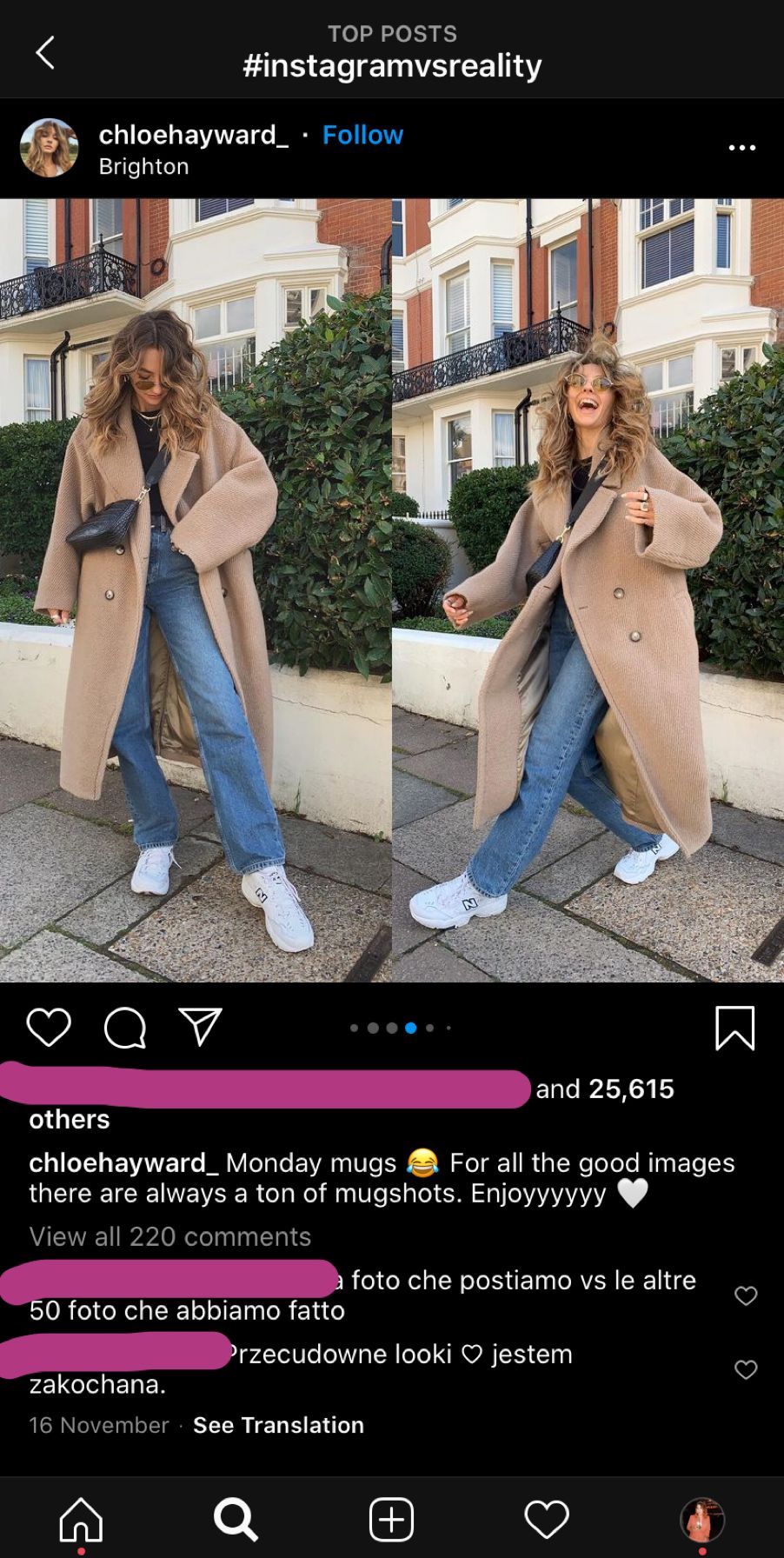
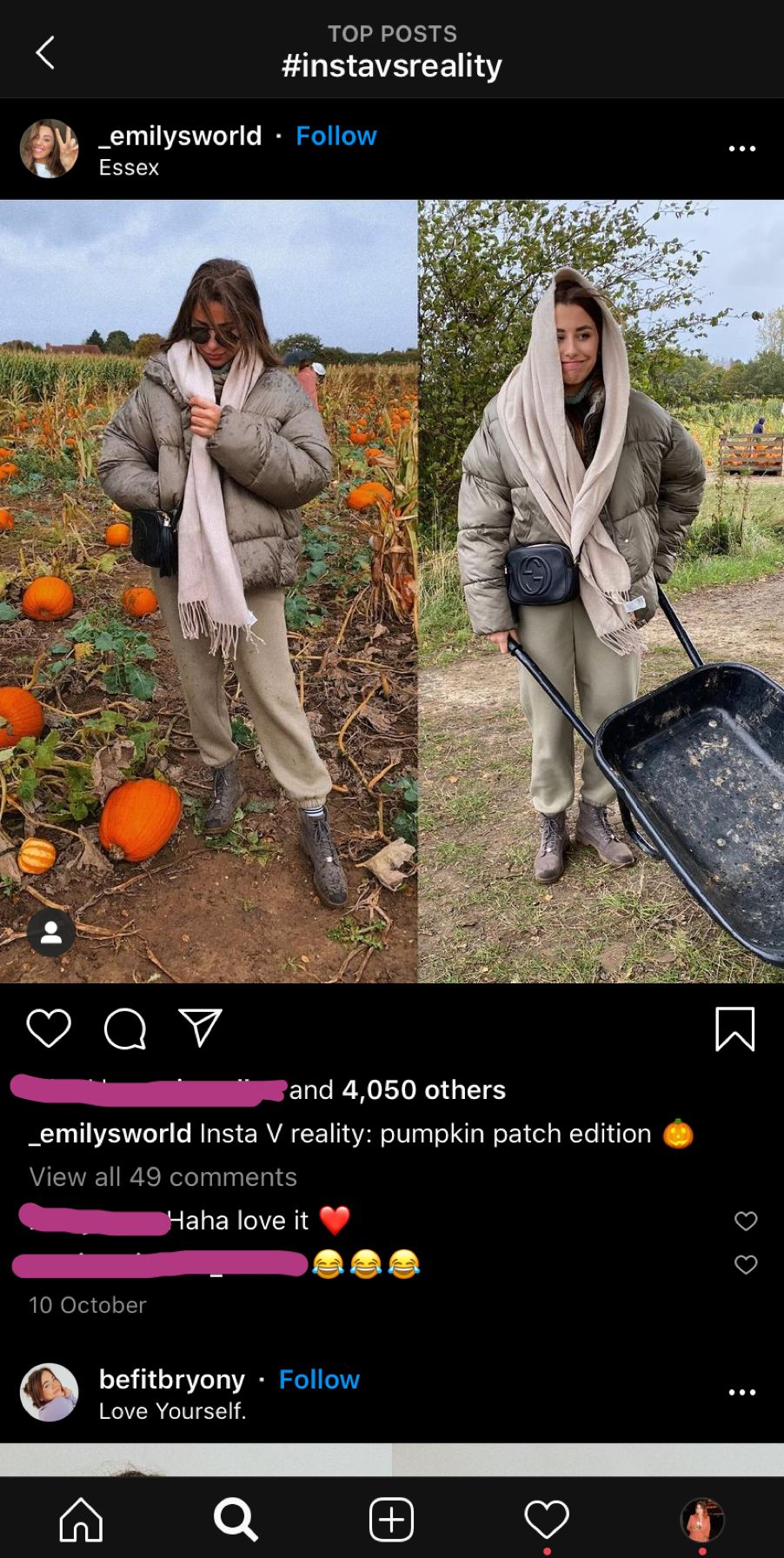
Megan Fell, a 24 year old hospitality manager from Durham, has expressed her concerns over the impact of Instagram on body image.
“Social media is quite a scary place when you think about it. There’s so much on there and so much you can’t control. Half of me feels motivated when I see fitness videos or yoga classes and I either take a screenshot or save the video to do it the next day, then I don’t end up doing it and end up feeling guilty with myself, like I've let myself down for not exercising. You always see women's bodies and are like 'well if i just do that for 3 weeks i’ll look like that' and it's an unhealthy mentality.”
Megan believes Instagram is great in some ways, as it lets us connect with friends, family and strangers, any time and any place. It gives us a view into what people get up to and the lives others are living. However, this has raised concerns for Megan as she believes that Instagram is just a snapshot of someone's life and checking it can become obsessive, as we are now constantly comparing other people’s lives to our own.
"People are always going to post what they want at the end of the day. I think it's up to the individual to appreciate other people's posts but not become obsessed. I have certainly done it where I've followed an influencer and wanted their life from the constant travel, to the so-called 'perfect' body, but it's unrealistic. I'm grateful I can differentiate it, some people, especially young girls, can't and that's where issues begin."
Photo of Megan Fell , Photography by Laura Benwell
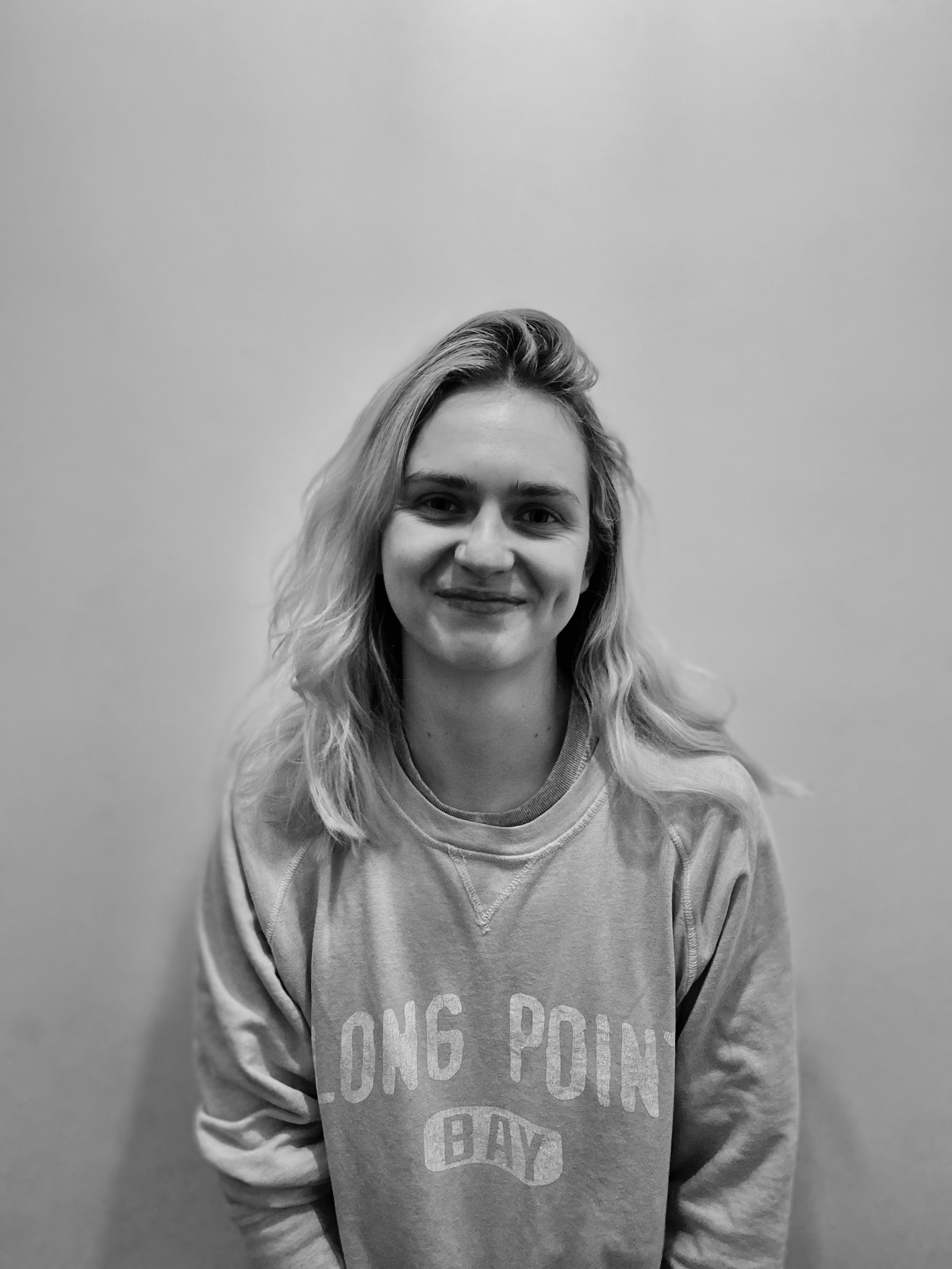
Similarly, Rob Sterlini said that ‘Instagram is nothing but a highlight reel’.

Rob discusses times where he has posted snapshots of his life on the platform whilst going through a rough time, yet it is simply not noticeable in photos, as he is smiling and presenting his “Instagram” life. Those who choose to join the world of Instagram have something to share, whether it’s a simple selfie, where you have travelled or what you’ve eaten that day; every picture is just a glimpse into your life. Some people are more private and don’t like to show too much, but others show everything. Importantly though, users only tend to share the good parts, as not many people would want to show their darkest moments, and this can be quite misleading. It is very simple to go through your feed and like each photo you see and not think there could be a story going on behind it.
Instagram’s culture is very much like that; posting the best photo you can, posing the best you can, editing it with a million apps and hoping to get as many likes as possible until the next post. It is normal to do this within today's society, as that is just the online culture we are in. Within seconds of logging on to social media apps, we are exposed to all sorts of imagery from others' experiences, jobs and their appearances, giving audiences the chance to immediately compare themselves.
Instagram has been known to be one of the most detrimental social media platforms to young people, having the most negative influence on their mental health and self esteem, despite having a lot of positivity on there. It's all to do with how young people choose to curate their Instagram homepage, and if they are selective about who they follow and therefore, what they see. As mentioned earlier, Chessie King is a champion for body positivity; she spoke to Women's Health magazine and said her first tip is about adapting your mindset, ‘try and filter through the thoughts,’ she suggests. Chessie also states that she ‘love[s] something that Alice [Living] says which is: control what you can control, but let go of what you can’t', and therefore, it’s in our power to choose who we see content from and take back control over our mental health and our social media feeds.
But this may be easier said than done for some, especially for those who are still in school or at university, as they have been overexposed to the unrealistic standard of what they should or could look like, and may not choose to change their feed out of fear of missing new trends or topics. As explained by Rob Sterlini earlier, the issue is that audiences do not see every single detail to one person's life - they only see the intensified, constructed version.
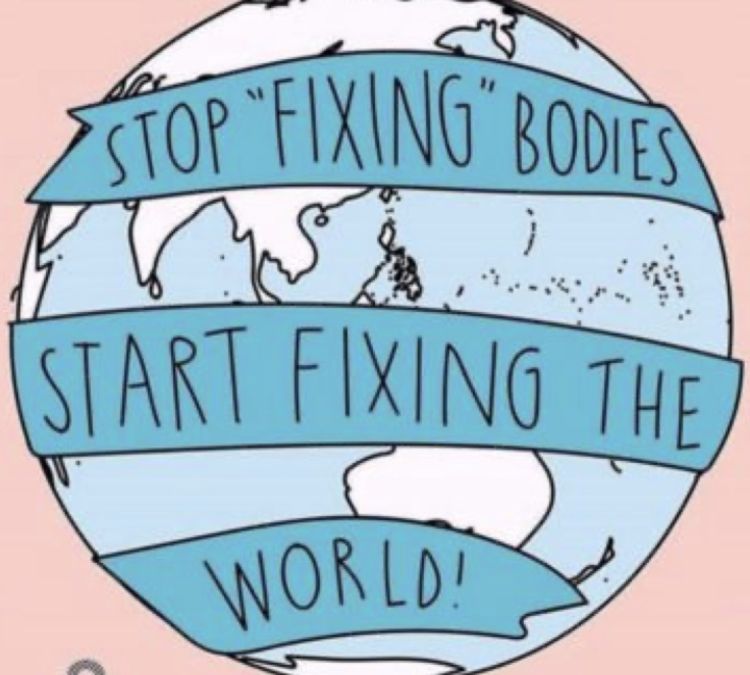
Image Credit: The Equality Institute
Image Credit: The Equality Institute
These self esteem issues can lead to anxiety and depression - especially in this current climate of Covid-19 where everyone is spending longer on their devices. Research has shown that activities such as uploading more photos and spending more time on social media are linked to much poorer body image issues than those who spend less time online.

Social media platforms are working to do something about this. In the last year, Instagram has introduced policies which restrict content related to weight loss products, dieting brands and cosmetic procedures. Jameela Jamil, an actor and activist, has said that this is a "huge win" in the fight against diet products and harmful body ideals on social media. But there’s still more than needs to be done, as the harmful images that present a certain ‘norm’ when it comes to body types are much harder to regulate, especially when many of the images are not posted with bad intentions.
Instagram could potentially make a big change and have a positive influence on users of the site by changing their own behaviour and promoting positive social media usage. Speaking with @harrietrb, she believes that real change could be made if Instagram’s own profile promoted body positive pages and discussed how to curate a mindful feed, setting an example to all of their followers. This could have a huge impact as Instagram’s profile is followed by 378 million accounts. These are the types of messages people want and deserve to see on social media. News outlets and social sites are used by millions of people and to break down unrealistic beauty standards and assist the future of the body positive movement, these sites must start engaging with their followers and start the conversation.
As mentioned above, Instagram has started doing this because as well as banning the use of advertisements for unhealthy weight loss products, they have taken it upon themselves to ban certain hashtags that are either triggering, inappropriate or damaging to mental health. Hashtags included are #depression, #eatingdisorder, #bpd, and any hashtags to do with self harm. If a user tries to search for these hashtags, it will either not show up or bring a warning up to them. Instagram doesn't want to condone any type of harm, but monitoring a site with over 1 billion monthly active users is quite tricky.
As of 2020, 63% of Instagram users visit the social platform daily. This statistic is notably scary, as so many users of all ages are exposed to so much potentially harmful content. With so many people visiting and posting on the platform each day, a human can’t possibly regulate all of the posts and hashtags that are uploaded. Sadly, this does mean that posts that may negatively affect mental health do go online. Unfortunately though, not everyone that sees these posts will realise that they are negatively impacting upon their mental health, so the more these images are posted, the more someone will subconsciously internalise the content they view. Therefore, although Instagram should spread more resources about how to curate a healthy social media site, Instagram could also look at how to stop the source itself, or at least warn of its harm. Although the platform is difficult to regulate manually, they could potentially create a new algorithm that picks up harmful posts, or enforce clear warnings to tell users that particular content is harmful in relation to unrealistic body standards, i.e. ‘This image includes filters and body sculpting edits’ . This would then allow users to see healthier representations of bodies, and also know when the body in the photo has been edited.
In 2019, Instagram co-launched a mental health campaign under the hashtag #RealConvo, and celebrities and influencers did engage with this hashtag, but it still only has just over 19K posts, unlike the hashtag ‘Instagram vs. Reality’ with 170K. So although Instagram is attempting to start conversations about mental health, the difference in numbers here shows that these campaigns need more recognition, especially in the fight to prevent suicide and other mental heath issues caused by social media.
So where does this leave the impact of social media in the future of journalism?
Social media influences how we view ourselves, both positively and negatively, and it’s important that we understand the effects of using social media platforms, such as Instagram, in order to limit their impact on our mental health. Growing up with social media can be a blessing and a curse, but without it, we wouldn’t have the opportunity to see beyond our own lives, or gain daily inspiration so easily.
There are many journalists who are advocates for body positivity, self-love, mental health and wellbeing. For example, Stephanie Yeboah and Danae Mercer are both freelance journalists, fighting for the cause and trying to tackle harmful body ideals online. Magazines and social media sites are trying to represent a wider range of body types through their advertisements and their online presence to make greater progress in combating body image issues. But all media, both traditional and new, need to continue to represent a range of different bodies, and move away from harmful editing software, and instead celebrate the uniqueness of every individual. As journalists, it is also important to be critical of all the trends that we see on Instagram and other social media platforms, in order to get a real idea of the progress being made, as well as the potential harm being done. By exploring these trends, journalists can challenge, promote and hold social media platforms to account.
Here is a quick vox pop style interview with Jessica and Lily Thourgood. Lily explains that she finds social media 'toxic' and Jess says how there is some improvement, but there is still a long way to go.
While it is positive that the ‘Instagram vs. Reality’ trend is gaining popularity and body positivity is being promoted to some degree, body image online still has a long way to go before all influencers and celebrities alike break the myth that all bodies have to be perfect. ‘Instagram vs. Reality’ has the potential to demystify the so-called perfection we see on a daily basis on social media, specifically Instagram. If Instagram users choose to follow influencers like Chessie King and Danae Mercer, they will potentially be more accepting of themselves, have more self-confidence and a better understanding of body image and positivity and how it can affect mental health.
There are many social media pages and websites on the internet for people who need support with body image issues and mental health problems. However, there does need to be a lot more information and work done on social media sites to promote healthy and realistic standards, and a positive relationship with social media. Influencers are definitely starting to embrace positive and impactful trends, creating a safer and happier space for people online, but there is still more to be done. With improvements being made through social media and journalism, people can try and find the balance between the internet and real life, and understand that not everything on social media is real.
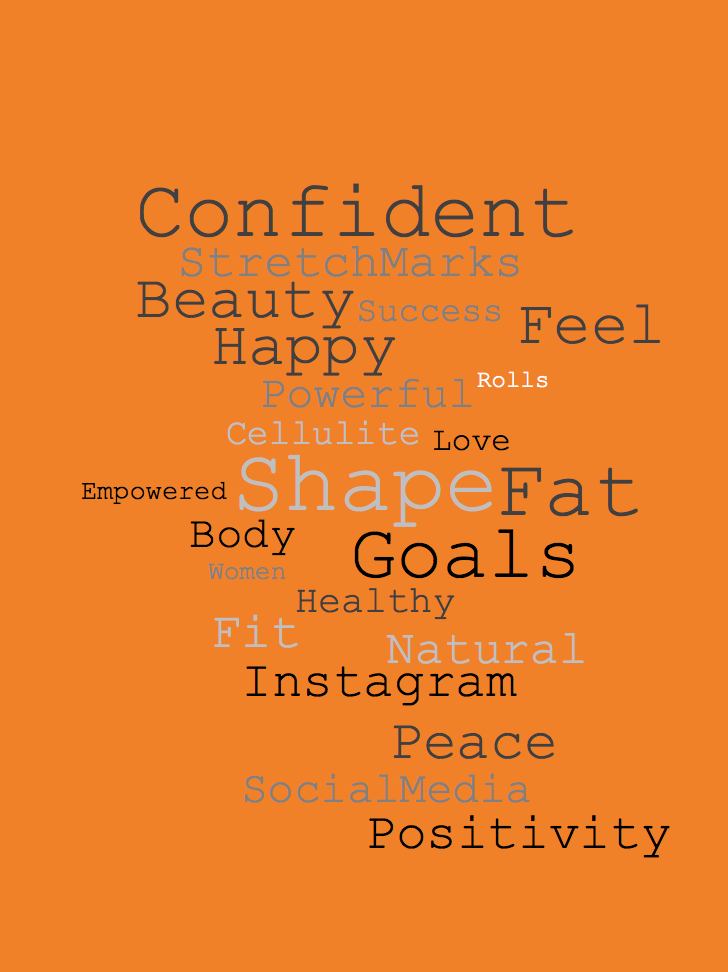
For more information on Body Image and Mental Health services, please see the links below:
MIND: https://www.mind.org.uk/information-support/a-z-mental-health/
Mental Health Foundation: https://www.mentalhealth.org.nz/get-help/a-z/resource/37/eating-disorders
Young Minds: https://youngminds.org.uk/find-help/feelings-and-symptoms/body-image/
